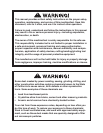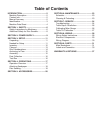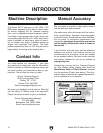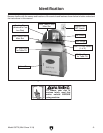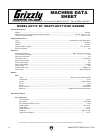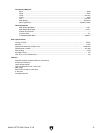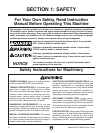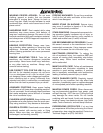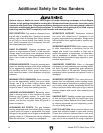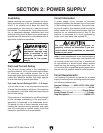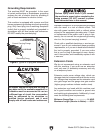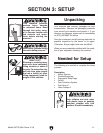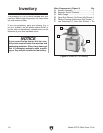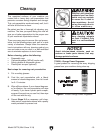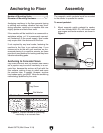
-8-
Model G0775 (Mfd. Since 11/14)
Additional Safety for Disc Sanders
WORKPIECE SUPPORT. Workpiece kickback
can occur with violent force if workpiece is not
properly supported during operation. Always sand
with workpiece firmly against table or another sup-
port device.
WORKPIECE INSPECTION. Nails, staples, knots,
or other imperfections in workpiece can be dis-
lodged and thrown from sander at high rate of
speed into operator or bystanders, or cause dam-
age to sandpaper or sander. Never try to sand
stock that has embedded foreign objects or ques-
tionable imperfections.
SANDPAPER CONDITION. Worn or damaged
sandpaper not only produces poor sanding results,
but could fly apart, aggressively grab workpiece,
and throw debris at the operator. Always inspect
sandpaper before operation and replace if worn or
damaged.
WORKPIECE INTEGRITY. Only sand solid work-
pieces that can withstand power sanding forces.
Make sure shape of workpiece is properly support-
ed on table; avoid sanding workpieces without flat
bottom surfaces unless some type of jig is used to
maintain support and control when sanding force
is applied.
SANDING DUST. Sanding creates large amounts
of dust and flying chips that can lead to eye injury
or respiratory illness. Reduce risk of these hazards
by wearing approved eye and respiratory protec-
tion when using sander.
DUST COLLECTION. Never operate without ade-
quate dust collection system in place and running.
Proper dust collection reduces dust in work area,
which decreases risk of long-term respiratory dam-
age, but it is not a substitute for using a respirator.
Serious injury or death can occur from fingers or hands contacting sandpaper, or from fingers,
clothes, or hair getting entangled in sanding disc. Workpieces thrown by sander can strike nearby
operators with great force. Long-term respiratory damage can occur from using sander without a
respirator and adequate dust collection system. To minimize risk of getting hurt or killed, anyone
operating machine MUST completely heed hazards and warnings below.
DISC DIRECTION. Only sand on downward-mov-
ing left side of sanding disc. Sanding on upward-
moving right side of sanding disc forces operator
to rely only on hands (rather than table) for sup-
port, which increases risk of workpiece “kick-out”
and impact/abrasion injuries.
HAND PLACEMENT. Rotating sandpaper can
remove a large amount of flesh in a few seconds.
Always keep hands away from sandpaper during
operation. Never touch moving sandpaper on pur-
pose. Use a brush to clean table of sawdust and
chips.
FEEDING WORKPIECE. Forcefully jamming work-
piece into sanding surface could cause workpiece
to be aggressively grabbed and pull your hands
into sanding surface. Firmly grasp workpiece in
both hands and ease it into sandpaper using light
pressure.
MINIMUM STOCK DIMENSION. Small workpiec-
es can be aggressively pulled from your hands.
Always use a jig or other holding device when
sanding small workpieces, and keep hands and
fingers at least 2” away from sanding surface.
AVOIDING ENTANGLEMENT. Becoming entan-
gled in moving parts of this machine can cause
pinching and crushing injuries. To avoid these
hazards, DO NOT wear loose clothing, gloves, or
jewelry, and tie back long hair. Keep all guards in
place and secure.
IN-RUNNING NIP POINTS. The gap between
moving sandpaper and fixed table/support creates
a pinch point for fingers or workpieces; the larger
this gap is, the greater risk of fingers or workpieces
getting caught in it. Minimize this risk by adjusting
table no more than
1
⁄16” away from sandpaper.



